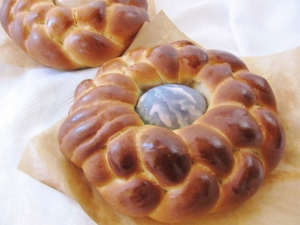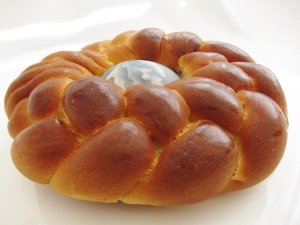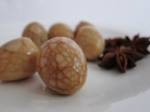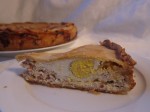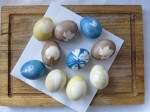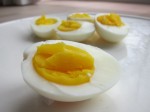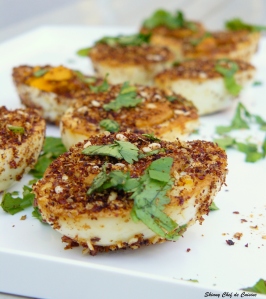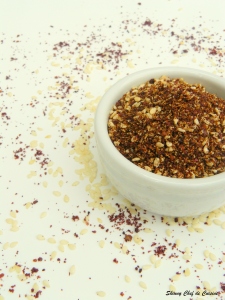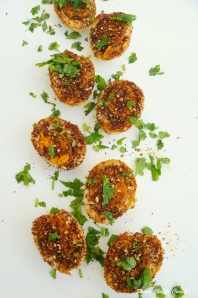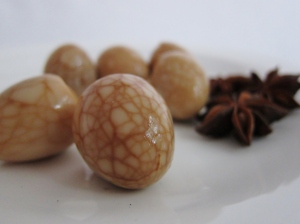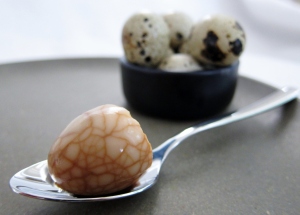The first days of spring always feel so tentative and so restrained: watery sunshine, pale buds. I wondered what I liked so much about this insipid season last year. And then spring burst out in its full extravagance. Suddenly there are almost endless hours of day-light (none of that hopeless saving of time). Everywhere you look there are vibrant greens bursting into life.
And then out of the blue there is Easter (was it not only just Christmas?)
As a kid Easter was spent hunting for eggs at my grandmother’s. Usually we first coloured them with those brightartificialdyes that came in tablet form, but I will never forget the year that my uncle arrived with all these littlesachet of natural dyes….including dried red insects. (The seed for my fascination for unusual ingredients was planted at a young age 🙂 )
Besides painting eggs we do not really have any family Easter traditions…Except for eating together of course. This means that I am free to experiment with other people’s foody traditions 🙂 One wonderful discovery has been this beautiful braided sweet bread circled around a dyed egg.
The tradition of eating sweetened bread for Easter may date back as far as the Homeric Greek period (ca. 1100–800 BC). The eggs echo the significance of Easter as they are traditionally connected with rebirth, rejuvenation and immortality. Or, viewed from a more practical perspective: eggs were forbidden during Lent, after 40 days there would have been plenty of eggs that had to be used up.
This bread tastes wonderfully sweet and light; it looks stunning on any Easter brunch table.
NB: Nowadays I tend to opt for slightly less exotic ingredients for dying eggs. For some ideas pop over to my post on dying eggs with natural ingredients.
Wishing you a Happy Easter!
Ingredients
(from the blog ‘Italian Dish‘)
4 breads
230ml (1,25 cups) milk
80g (1/3 cup) butter
1 package of instant yeast (about 3 tsp)
pinch of salt
80g (1/2 cup) sugar
2 eggs
350-500g (3,5 cups) flour
1 egg
6 dyed eggs (they can be dyed raw as they will bake in the oven)
Recipe
- In a small saucepan, warm the milk and butter until the butter just melts. Do not let the milk get too hot (or allow it too cool before adding it to the yeast).
- In a large bowl combine yeast, salt and sugar.
- Add the eggs and mix.
- Add the warm (not hot!) milk and butter mix.
- Add about half the flour and combine using the dough hooks of your mixer. Mix until smooth.
- Slowly add the remaining flour to form stiff dough. (The amount of flour needed will vary. You are looking for dough that is not sticky any more.)
- Knead the dough (either by hand or in a stand mixer) until the dough is pliable and soft.
- Lightly oil a bowl. Place the dough inside. Cover with cling film and allow to rise in a warm place until doubled – for about one hour.
- Prepare two baking trays by lining them with parchment paper.
- Punch down the dough. Divide into 12 pieces. Roll each piece into a rope (about 2.5cm / 1 inch thick and about 35cm/ 14 inch long).
- Taking three pieces at a time, braid them together. Loop into a circle, tucking the ends inside.
- Cover with cling film and allow to rise in a warm place until double – for about 30 minutes.
- Heat the oven to 175C (350F).
- Beat the remaining egg and brush over the bread.
- Place a dyed egg in the center of each bread, pushing it down slightly.
- Bake about 20 min until ht bread is golden brown.
- Allow to cool on a rack.
- Note: If you leave the bread out for a few hours you should no longer eat the eggs.
More Easter and egg recipes
